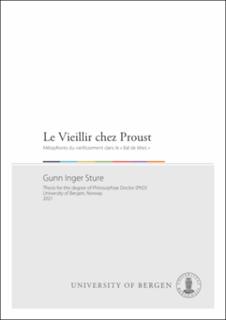Le Vieillir chez Proust : Métaphores du vieillissement dans le « Bal de têtes »
Abstract
In the “Bal de têtes” – the final scene of Marcel Proust’s À la recherche du temps perdu – ageing becomes the primary subject of the narrator’s reflections. Confronted with the aged faces and bodies of friends and acquaintances he has not seen in years, he struggles not only to recognize them, but also to understand and come to terms with the changes they have undergone. This study explores metaphors of ageing in the “Bal de têtes”, and seeks a better understanding of what they can tell us about the Proustian conception of human ageing and of the ageing self. It draws on conceptual metaphor theory as well as Paul Ricœur’s tensional metaphor theory in order to analyse the rich complexity of interwoven metaphors found in the descriptions of aged characters.
Time, in la Recherche, is a paradox: on the one hand, it passes constantly and is lost, but on the other, it can be recaptured through memory and through art. I argue that this paradox is an important aspect of Proustian ageing as well. Time causes ageing and changes the characters, but it is also accumulated and preserved both on their bodies, as signs of ageing, and in their memory.
The descriptions of aged characters are often unfavourable, and the academic literature on the “Bal de têtes” often emphasises the cruelty of the narrator. While loss and deterioration are important aspects of ageing in la Recherche, I argue that the metaphors used in the “Bal de têtes” provide nuance to its representation of this process. The most frequently exploited metaphors in the “Bal de têtes” present ageing as a process of artistic creation, thus attributing to the characters the status of works of art. This is particularly significant in la Recherche, where art is not only highly valued, but also holds the capacity to counterbalance the effects of time.
In quite a few of the descriptions of aged characters as works of art in the “Bal de têtes”, time is personified as the artist responsible for them. Time the artist often keeps adding on layers – of paint, for instance – to the faces of the characters, thus creating a sort of thickness. This, I argue, makes time a model artist for the narrator, who wants to describe the temporal “thickness” of the characters in his novel. Ageing can thus be considered as a source of Proustian aesthetics, not only, as is explicitly stated in le “Bal de têtes”, because the fear of his own ageing makes him realise the need to start writing before it is too late, but also because the process of ageing can be understood as a process of artistic creation.
According to both conceptual metaphor theory and Ricœur’s tensional metaphor theory, a metaphor consists not of a substitution, but of a superposition of domains. The narrator seeks the capacity to render the “thickness” of aged human beings in writing, where there is no concrete matter such as paint, and the metaphor is the tool that will allow him to do so. Metaphor also allows Proust to illustrate important aspects of memory, art and ageing – both because of the superposition it implies and because of the tension between difference and similarity that Ricœur sees as one of its inherent qualities. In a metaphor, ageing can remain an unsolvable paradox – at once transformation and accumulation, destruction and creation, evanescence and permanence, provoking both pessimism and fear, but also fascination and admiration.
